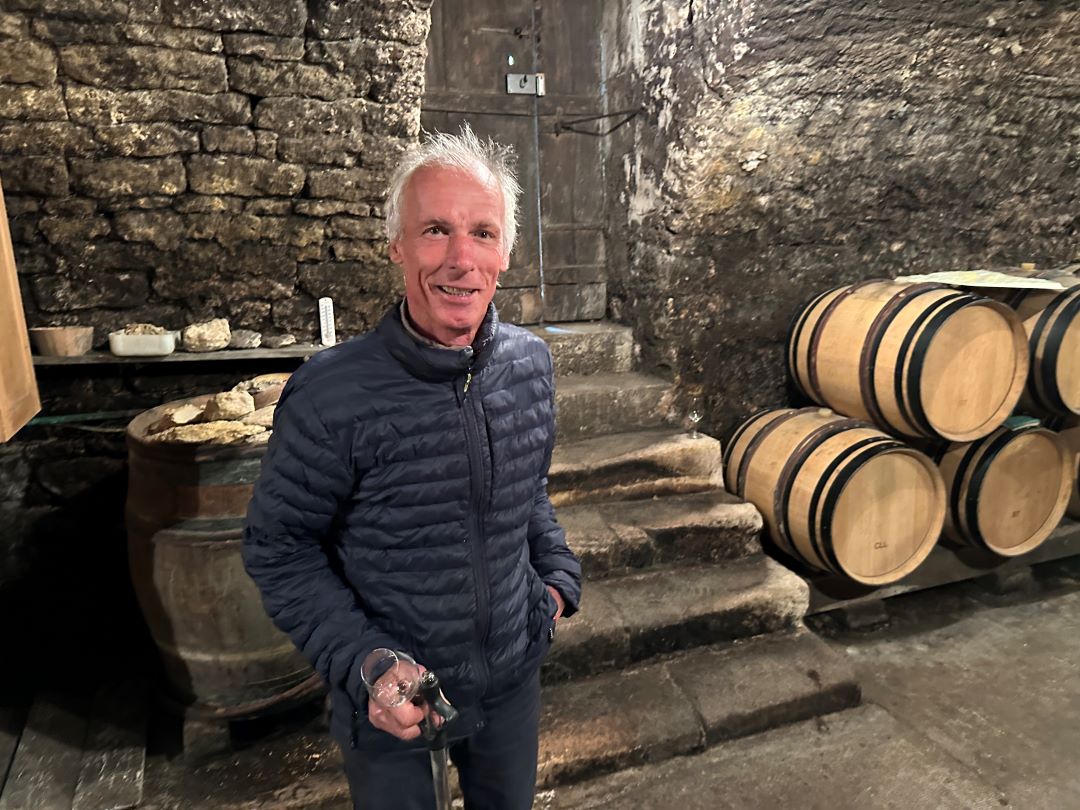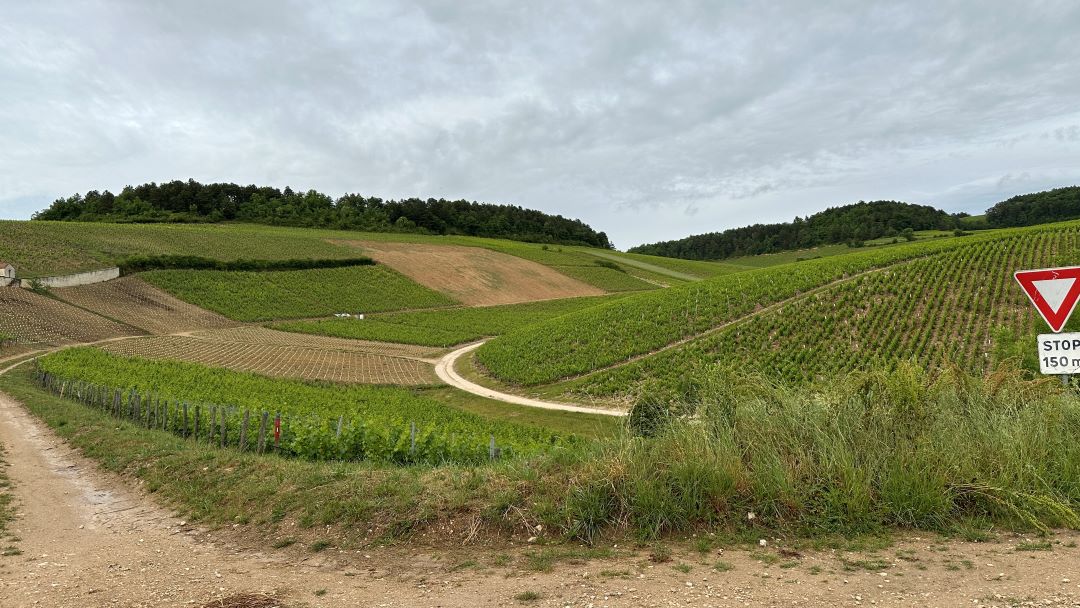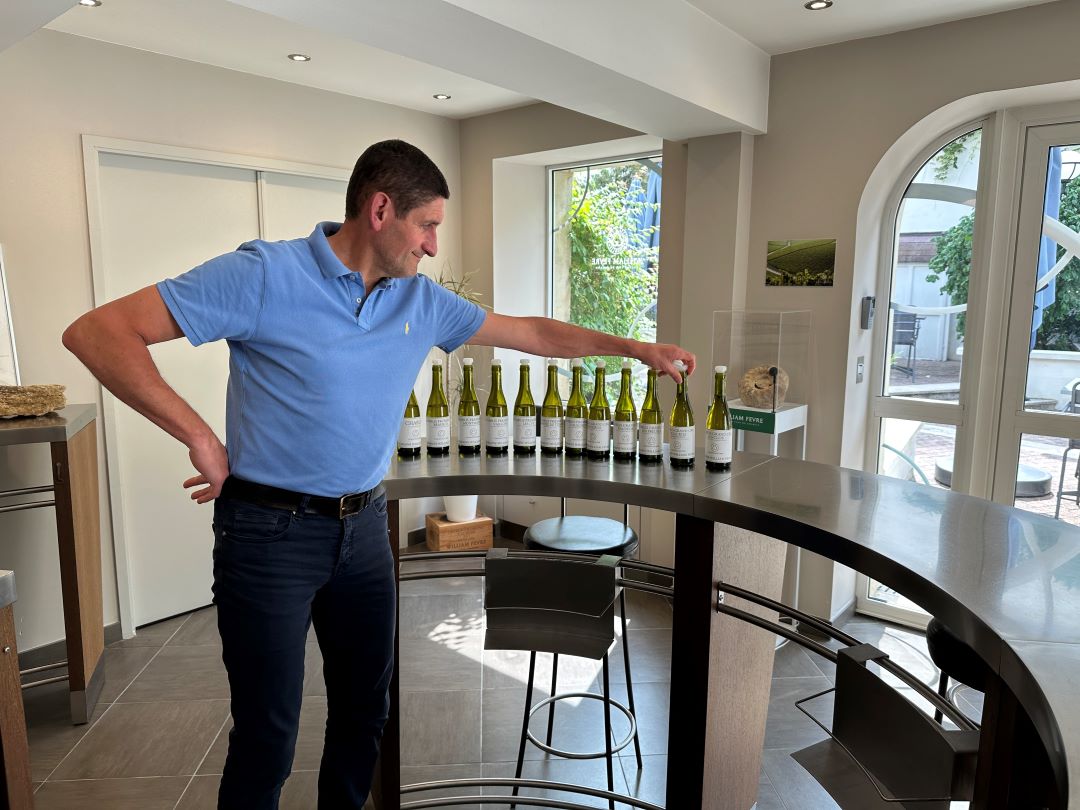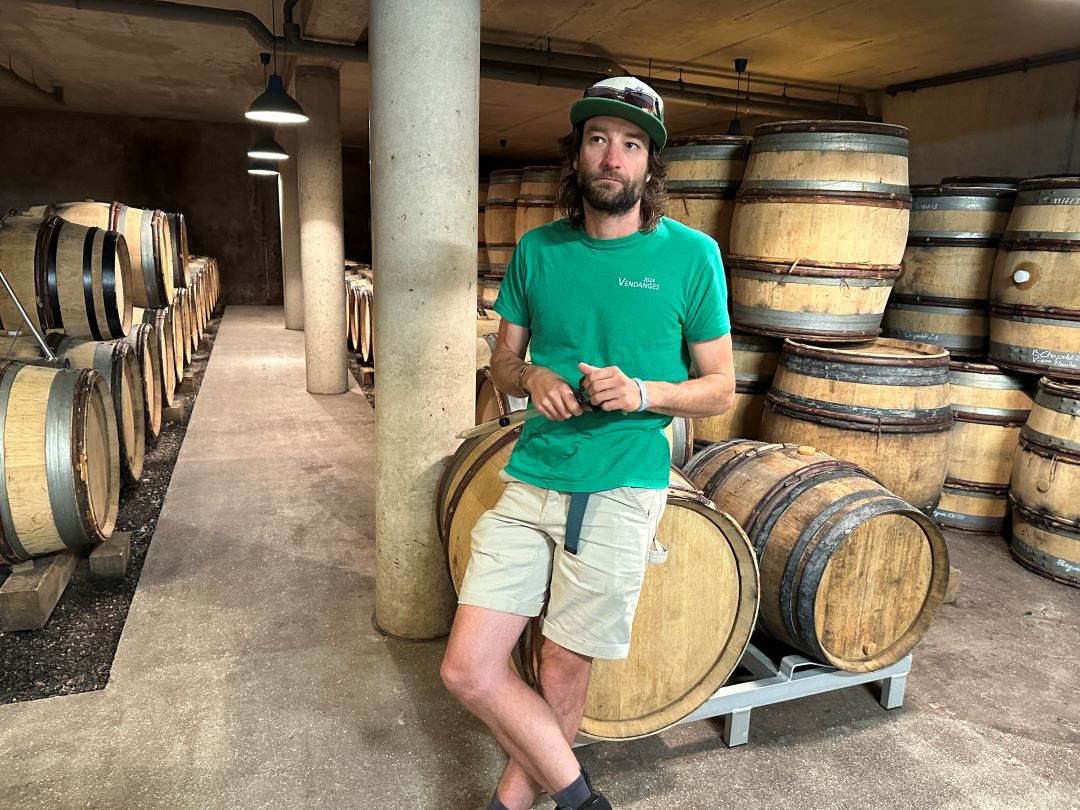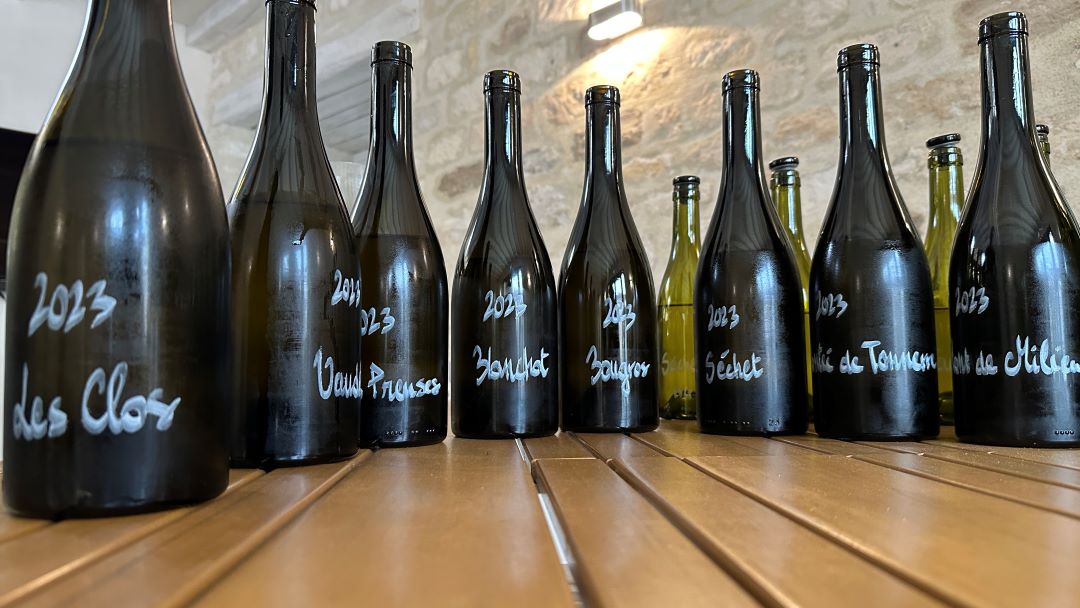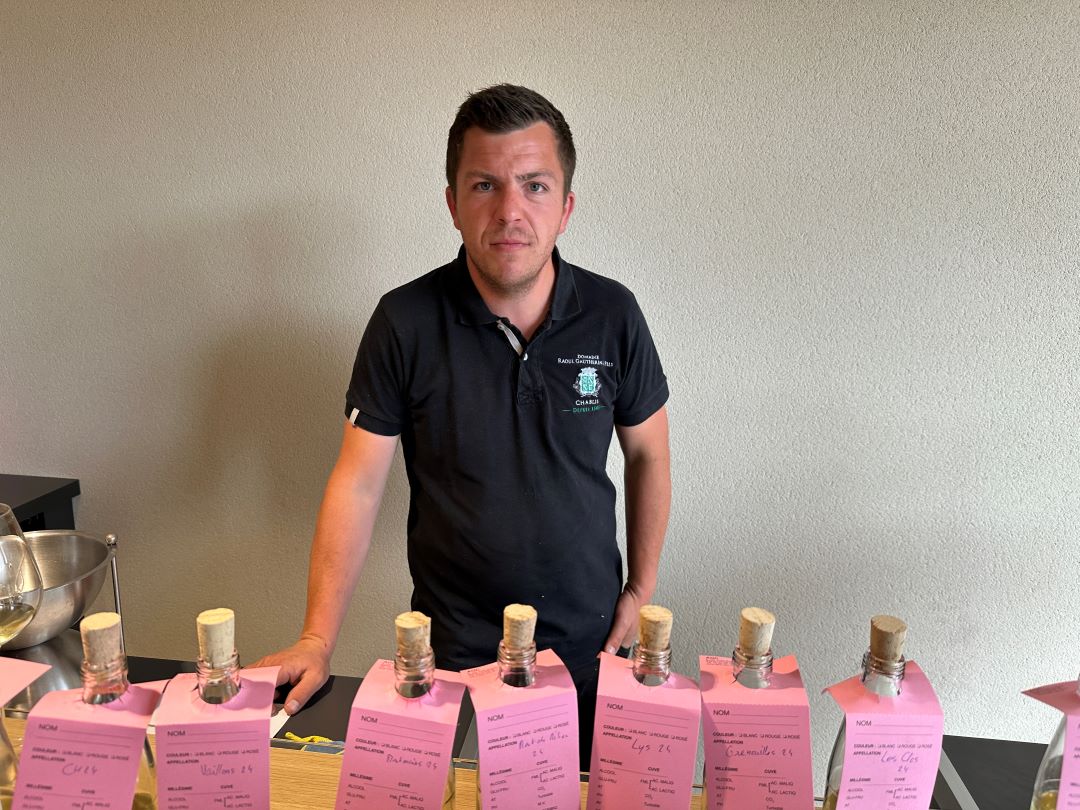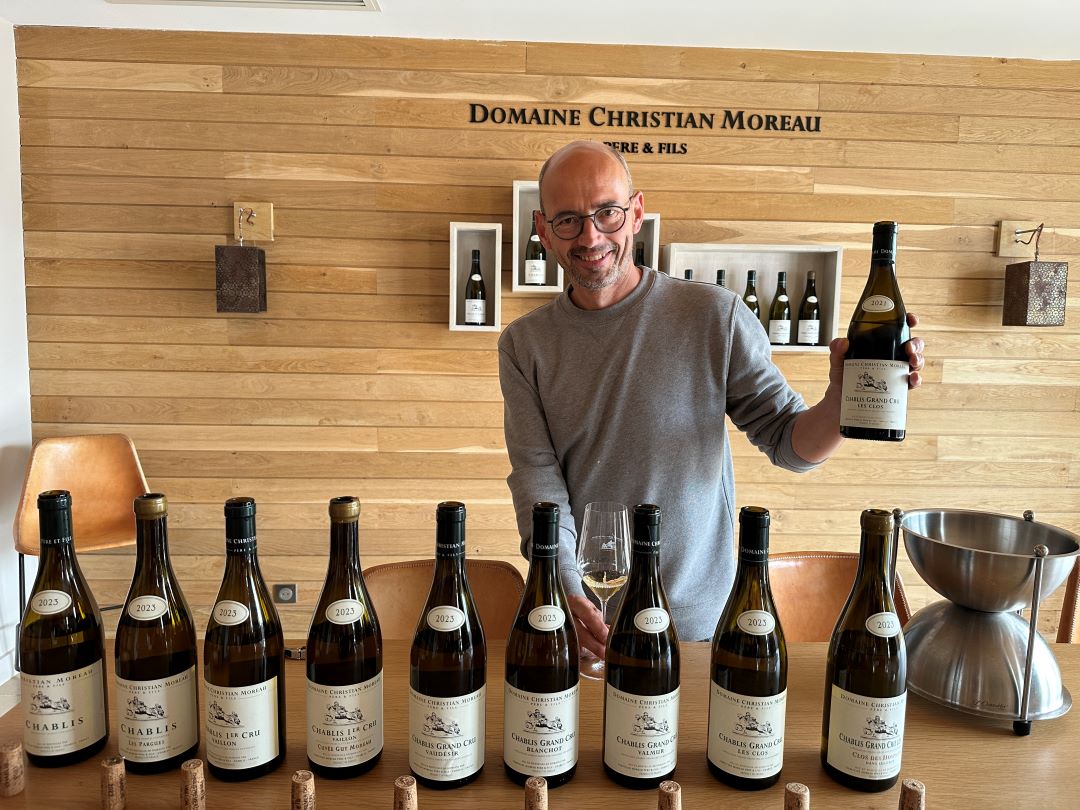Browse using the new Vinous website now. Launch →
Printed by, and for the sole use of . All rights reserved © 2015 Vinous Media
Chablis 2023 & 2024: Five Baskets
BY NEAL MARTIN | JULY 24, 2025
“Cinq paniers…” the winemaker replies.
I visualise those words in my head, picturing Vincent Dauvissat’s dismay as he counted them last September. Five baskets. Two words that encapsulate what many Chablis winemakers endured in 2024, a torturous growing season that piled on the misery with relish. I had asked Dauvissat about the yield in his 1.7 hectares of Les Clos. I anticipated a desultory figure in hectolitres per hectare, but in this season of pitiful volumes, “basket” is the new metric. Five baskets? I’ve bought more grapes on a trip to the supermarket. Dauvissat’s reply is imbued with regret and farce. It would be comical if peoples’ livelihoods were not at stake.
Vincent Dauvissat, pictured in his cellar after showing me the handful of barrels that comprise the totality of his 2024 yield.
Nature—or more accurately, rampant mildew—decimated Les Clos, marching upslope from the deep clay and consequently more humid lower section without remorse, without a flicker of respect for vineyard or reputation. I always impress upon readers how Chablis’ northerly latitude consigns it to permanent flirtation with disaster, analogous to one of those free climbers on TikTok who film themselves dangling precariously from skyscrapers. They risk life and limb out of volition. Chablis was born on the ledge of a marginal climate, one that predicates distinctive Chardonnay. This endowed Chablis almost ubiquitous familiarity, the cost being that, historically, only a couple of vintages each decade would ripen fully while the rest were written off. Global warming has reduced that cost. Nowadays, grapes ripen more regularly, but winemakers contend with unprecedented levels of meteorological turbulence. And when the growing season is benevolent, Chablis is accused of forsaking its traditional style that distinguished it from the Côte d’Or. In other words, Chablis cannot win, which is probably how Vincent Dauvissat felt as he wondered what to do with those five baskets.
When I returned to Chablis in May of this year, winemakers were enjoying a relatively benign season thus far, free from late spring frost or mildew. Flowering had passed without a hitch and was in its final furlong. (Mother Nature had instead meted out malevolence upon the Mâconnais in the form of severe hailstorms.) Chablis’ winemakers were still reeling from the previous year’s rollercoaster ride, silently praying that 2025 would give them not stellar wines—even though that is always welcome—but decent volumes to replenish empty cellars.
This photograph illustrates the varying orientations of the Grand Crus, this one depicting Les Preuses. You can see where parcels have been pulled up.
Growing Seasons
Like elsewhere, the 2023 vintage commenced with mild conditions, not least in January when temperatures averaged 5°C before dropping the following month. February was particularly dry, with just 9 mm of rain. Despite the comparatively warm winter, budding was around normal. After a slightly warmer March that welcomed 74 mm of rain to replenish the aquifer, April witnessed what is quickly becoming an annual event: temperatures fell to 9.4°C on average and caused localised frost damage in exposed areas on April 4 and 5. At least April saw another 58 mm of rain to top up underground moisture reserves, though this made vineyard work more difficult. Even at this early stage, vineyard managers began to notice heterogeneity between parcels, a characteristic of the vintage that lasted until the end of the season.
May was sunny with average rainfall, though this clemency was a false dawn. June was wetter with 76 mm of rain, albeit far less than in Mâcon, which saw nearly twice that amount. Thankfully, there was quite a bit of sun, with an astonishing 314 sunlight hours recorded. Flowering was therefore smooth and even. The first flowers were spotted on June 1, and mi-floraison was recorded on June 9, only a couple of days earlier than normal. The latter half of June saw intermittent showers, meaning powdery and downy mildew were a constant threat. Vigilance was key. “We had a lot of mildew pressure, more than I've ever seen before,” Jean-Marc Brocard commented. “It came quite late, from mid-June, and very quickly infected the bunches.” Precipitation continued from June to August with 76 mm, 72 mm and a soggy 95 mm for those three months, which engorged the berries. William Fèvre Winemaker Didier Séguier told me they could weigh 200 grams, whereas they averaged 58 grams in 2019. But Séguier went on to suggest that the rain stopped at just the right moment, remarking that the crop would have been decimated by botrytis had rain continued even a couple more days. As is often said, Chablis is winemaking on a knife edge.
Winemaker Didier Séguier at William Fèvre, now a stablemate with Lafite-Rothschild. I don’t think I asked him to do an impression of a teapot, but thank you anyway.
The first pickers started on September 7, others opting to wait a few days when they felt the fruit needed more ripeness. Some teams, such as those at Drouin, went out into the vines early in the morning to preserve freshness, which they knew would be difficult to obtain otherwise. It should be noted that, unusually, some domaines undertook a pre-emptive spray of copper after the harvest.
The 2024 season…I mean, where do you start? The cover photo in the BIVB 2024 vintage report depicts a large puddle, a tacit way of saying that it rained. The town flooded twice.
The figures are stark. Chablis was constantly drenched: 128 mm in March, 196 mm in May and 117 mm in June compared to the previous year’s 74 mm, 40 mm and 76 mm respectively. There was no respite, nary a dry window to protect vines from mildew, exacerbated by the quagmire underfoot that made tractors treacherous to steer. A side order of hail to accompany your woe, sir? According to Didier Séguier, there were two hailstorms in April and another in May, the latter destroying 40% of their production. Should I mention the severe frost as well?
When I visited the region last year in an atypically dry week, some winemakers had already written 2024 off. They were physically and mentally exhausted. Those who are organic or biodynamic, unable to resort to arguably more effective chemical sprays, had it harder. Irrespective of vineyard husbandry, you had no option but to be constantly in and out of the vines. Vincent Dauvissat sprayed 23 times, Julien Brocard 18, Edouard Vocoret 19. Though not certified, Vocoret clung to organic practices until 100 mm of rain fell in a week, and he reluctantly switched to a synthetic spray. Guillaume Michel at Louis Michel & Fils sacrificed his organic certification, fearing a financially untenable total loss of crop. He plans to continue farming organically but is not inclined to undergo another three-year application period and will not seek recertification. It goes without saying that temperatures and solar hours were way below average, but if you want them, April to September saw temperatures 0.2°C below normal, 97 hours fewer of sunshine and 29% more rain.
Edouard Vocoret momentarily considered blending his Grand Crus together mere months after inheriting them.
The knock-on effect was that harvest began later than normal. Perhaps a few winemakers were becoming accustomed to pickers entering the vines at the end of August, but in 2024, most teams trooped into vineyards around September 20. Spirits had been lifted by August’s more clement weather, with a much-needed 263 sunlight hours and average temperatures of 21°C—albeit with 78 mm of rain, over twice as much as in Mâcon down south.
During picking, the mercury tumbled to average temperatures of just 15.3°C (compared to 19.0°C in 2023). In some ways, harvest was easier because there was less to pick. On the other hand, pickers had to be more meticulous about what they put into their baskets. Though the headline is that the region picked half the normal amount of fruit, yields did vary between vineyards. Even in this challenging season, some cuvées achieved an almost normal yield.
The complications did not stop there. Winemakers had to fill their presses—easier with a vertical basket press but harder with a horizontal pneumatic press—then transfer sufficient must to fill their vats for alcoholic fermentation. Some producers, like Goisot, were lucky to already have smaller vats at their disposal, but others had to think on the spot. For example, Lilian Duplessis used two 500-litre demi-muids instead of his usual vat. Another option was to use floating vats with an adjustable capacity, though as Guillaume Michel mentioned, these risk oxidation and you must adjust SO2 levels. Then you have the tricky task of maintaining barrel rotation because, as Isabelle Raveneau noted, you don’t want to leave them empty.
How the Wines Were Tasted
I tasted the wines for this report in Chablis at the beginning of June 2025. It is important to note that wines at the BIVB office were poured blind in order of their status, beginning with Petit Chablis, then Premier Crus and finally Grand Crus. Afternoons were devoted to winery visits, so obviously I wrote those notes sighted. Each tasting note indicates whether I tasted the wine sighted or blind. Although this report contains over 500 reviews, there are still a handful of growers I intend to add in the future. Either I ran out of time or, occasionally, winemakers were busy in the vines or in the middle of bottling, like Patrick Piuze. Plans are already in place to add more reviews this September when I next return to Burgundy. This year, I have folded my reviews for Irancy and St.-Bris in with Chablis.
The Wines
Chablis is tricky to review because opinions diverge as to what its contemporary wines should deliver. Chablis’ tropes are green apple aromas and what I sometimes call “cool glade” scents—shady, perhaps mossy. It is not “sunny” like a Chardonnay from the Côte d’Or. The palate should be underpinned by noticeable acidity and the mineralité derived from its Kimmeridgian clay. Chablis should be tensile and saline. Old-school Chablis is a bit mean, like the boyfriend/girlfriend who gives you the run-around and yet that fuels their attractiveness. Alcohol ought to be on the lower side. C.W. Berry wrote in his mid-1930s book “In Search of Wine” that Chablis’ alcohol levels would be just 8° in an average year and 10° in a good year.
Climate change is manifesting a different Chablis, erasing that meanness and coolness and replacing them with tropical traits, lower acidities, fatness, gras-like texture and alcohol levels that would make Mr. Berry spit out his Blanchot. Within this new idiom are good and bad examples. A purist would denounce modern Chablis altogether and reminisce about the Chablis of yore, perhaps accusing the region of selling out. But this stylistic change is not brought about by winemakers altering their approach (which is arguably the case in Saint-Émilion or Napa). It is dictated by changes in growing seasons, not least warmer summers. If the duty of wine is to reflect its terroir and climate, then whether you like it or not, today’s Chablis wines are simply upholding their duty. There are unequivocally delicious examples of contemporary Chablis. Should they be downgraded because they have been forced away from entrenched notions of traditional Chablis, even if they are balanced, fresh and flavoursome? There is no correct answer. Without wishing to sit on the fence, I examine all the virtues of a great Chablis and then factor in whether it is a good or bad example vis-à-vis its peers.
Look out for the wines of Raoul Gautherin & Fils. Young winemaker Adrién Gautherin clearly has talent. Gautherin and his father, Alain, have an enviable array of holdings at their disposal.
I expressed my sentiments regarding 2023 in last year’s report. I wrote that the 2023s “don’t achieve the same heights as the previous vintage” and that the challenge was for winemakers to imbue their wines with personality, to articulate their respective terroirs despite the tendency for warm growing seasons to even out nuances. Expanding my purview 12 months later, I am slightly more positive about how these wines might evolve. No, they will not appeal to purists who seek traditional Chablis, because they veer more towards tropical flavours. They are certainly not tropical like a Mediterranean or Australian Chardonnay, even if, as my colleague Angus Hughson reported, the latter has moved away from that style. Imagine a canvas that depicts traditional Chablis aromas and flavour, upon which a painter has made discrete tropical “brush strokes.” In the hands of good winemakers, these engender worthy articulations of Chardonnay, so long as there remains countervailing acidity, tension and mineralité to maintain some similitude to “antediluvian” Chablis. In other words, with correct viticulture, earlier picking and prudent vinification, you can fit both traditional and contemporary Chablis into one bottle.
I tasted most of the 2024s at wineries, the majority from barrel. As I intimated earlier, one must assess the wines on their own merits. Guide yourself by what you taste rather than galloping to conclusions after a cursory perusal of the growing season. It was a vintage that most producers never want to repeat, but as memories of those hard days and sleepless nights slowly fade, and focus moves from vineyard travails to the resulting wines, there is simmering positivity. There is no getting past the fact that quantities are small in 2024, though that varies between locations. However, it was possible to fashion Chablis with lower pH levels and plenty of tension. Gaëlle Ribé at Château de Béru was not the only person who opined that the late harvest concentrated tartaric acid. Likewise, several commented that the wines are benefitting from extended barrel maturation, which is also the case in the Mâconnais.
On the other hand, I feel that the 2024s occasionally lack a bit of energy on the finish, as if the vine had exerted so much in surviving the growing season that the fatigue manifests in the wine. That is not the case for all the samples tasted, but it became clear when juxtaposed against their 2023 counterparts. It is a vintage that I am eager to reassess in bottle, though the extent to which that will be possible depends on whether growers can sacrifice a bottle.
Winemaker Fabien Moreau at Domaine Christian Moreau & Fils. His family’s parcels were acutely impacted by hail and mildew in 2024, but he still has a smile on his face.
The Cost of Certification
As an aside, I have thought a great deal about organic and biodynamic certification. The 2024 vintage prompted some of even the most ardent practitioners to question their modus operandi. Let me state for the record that, even though vineyard practices do not influence my assessments of quality one iota, I totally advocate any incentive that benefits the environment and improves working conditions. In a perfect world, all producers would be organic, as you could argue they unwittingly were until the sixties. Certification is a guarantee that a wine is produced according to the rules, a reward for going that extra mile.
However, winemakers must make a living. A philosophical stance means nothing if it results in no fruit. Journalists might proselytise vineyard practices from behind their computers, but we are not the ones waking up at the crack of dawn to mount our tractors. Two thousand twenty-four pushed producers to the brink. Nobody should begrudge a winemaker who reluctantly used synthetic sprays when their entire crop was in jeopardy. Many are currently weighing the negative effects of using chemicals versus heavy spraying of copper throughout the season and evaluating the long-term consequences of that build-up in the soil. And by the way, those tractors run on petrol. There’s a cost to the environment that some consider greater than just one or two synthetic treatments. At present, certification bodies give no leeway. Meanwhile, winemakers are aware that many merchants’ and sommeliers’ short-sighted criteria are based on whether a wine is certified or not. You might save your crop at the cost of your customer base.
Visiting Chablis
Visiting Chablis is an absolute joy. In fact, I probably should not be espousing its virtues because I adore its blissful tranquillity. One evening, walking to a restaurant, I did not see a single person. It was like the opening scenes of “28 Days Later,” without the zombies. Despite its diminutive size, the namesake town boasts excellent places to dine, and word seems to be catching on. Perhaps my favourite establishment is ‘Wine Not?’ Expect a Vinous Table soon. ‘Au Fil du Zinc’ is fine, but I feel the current chef is too adventurous and some more unorthodox combinations don’t quite work. Finally, there is ‘Maufoux,’ which can be summed up with “delicious grub/killer wine list.” Chablis is one of the last bastions where you can drink excellent wines without paying over-inflated prices. It puts many of Beaune’s bistros to shame. What Chablis does not have is many places to stay. In an odd way, that’s a good thing.
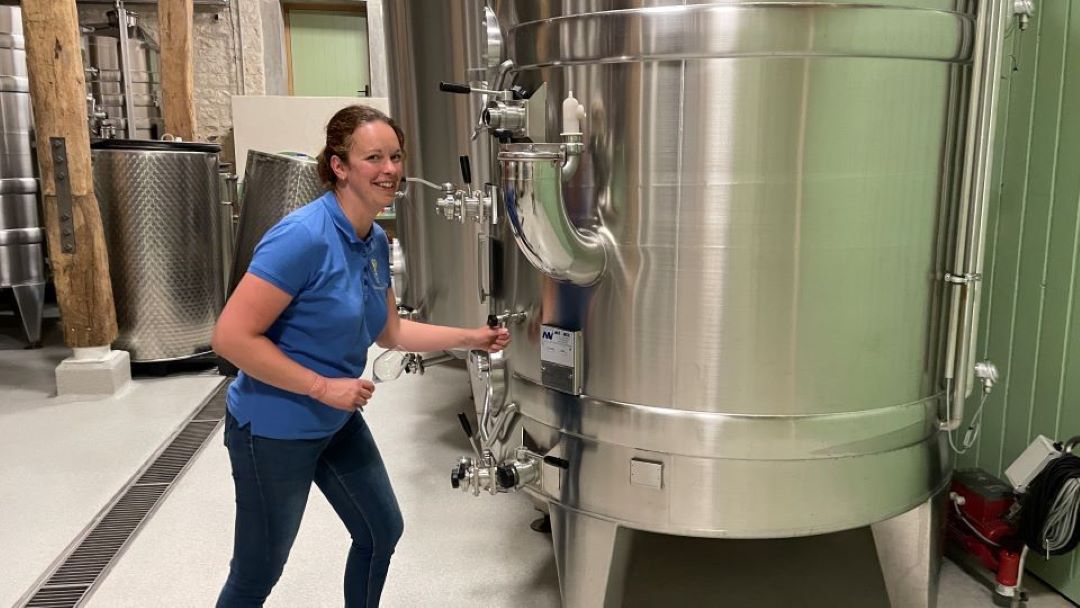
Winemaker Gaëlle Ribé at Château de Béru.
Final Thoughts
The 2024 vintage tested the mettle of every Chablis winemaker. It’s a credit to their steely fortitude that they survived…just. These winemakers are becoming inured to being on tenterhooks all the time. The repercussions are both immediate in terms of a severe shortfall in quantity—though alleviated by an abundant crop in 2023—and longer-term with respect to lingering questions over eschewing synthetic sprays. If growing seasons that mandate multiple treatments of copper become more frequent, that will surely pose its own consequences. Is there a middle road? To my mind, there is, maybe in terms of permitting, say, just one non-organic treatment within a stipulated period of time in order to get growers over the hump.
Top-tier producers in Chablis are conjuring wonderful wines. No disrespect to either, and I am sure they would agree themselves, but Chablis is not just Raveneau and Dauvissat, though both have inspired a legion of vignerons. It is important that the region fosters new talent. Perhaps that is what the region is missing…new blood. Whereas the Côte d’Or is flooded with micro-négociants with all the attendant good and bad that follows, this has not happened in Chablis to nearly the same extent. Some growers expressed a wish that such a phenomenon not occur in Chablis, lest it cause a similar scrabbling for overpriced fruit to overcharge customers.
The 2023 vintage is well worth investigating. There are some lovely wines that should have wide appeal, perhaps except for those consumers hankering for the kind of wines produced pre-global warming. Nevertheless, it will be intriguing to see how these wines age, even if they are wont to give immediate drinking pleasure. The 2024s will dribble into the market next year. Hopefully, 2025 will be an abundant vintage. Henceforth, Chablis has a new benchmark for the most stressful growing season ever. At least the vines reignite their engines every year, impelling winemakers to do likewise. At the time of this writing, Vincent Dauvissat expects more than cinq paniers.
© 2025, Vinous. No portion of this article may be copied, shared or re-distributed without prior consent from Vinous. Doing so is not only a violation of our copyright but also threatens the survival of independent wine criticism.
You Might Also Enjoy
Chablis 2022-2023: Here Comes the Sun King, Neal Martin, August 2024
Where Art Thou Chablis? - Chablis 2021 & 2022, Neal Martin, September 2023
Swings and Roundabouts: Chablis 2020/2021, Neal Martin, September 2022
Chablis’ Satellites: Irancy & Saint-Bris, Neal Martin, November 2021
Life on the Margin: Chablis 2019/2020, Neal Martin, October 2021
Show all the wines (sorted by score)
- Athenais
- Baudouin-Millet
- Benjamin Laroche
- Caves Bailly Lapierre
- Château de Béru
- Clotilde Davenne
- Domaine Alain & Cyril Gautheron
- Domaine Alain Geoffroy
- Domaine Alice et Olivier de Moor
- Domaine Bachelier
- Domaine Bardet et Fils
- Domaine Bernard Defaix
- Domaine Besson
- Domaine Billaud-Simon
- Domaine Camille et Laurent Schaller
- Domaine Céline et Frédéric Gueguen
- Domaine Chaly Nicolle
- Domaine Château de Fleys
- Domaine Christian Moreau Père & Fils
- Domaine Christophe et Fils
- Domaine Courtault Michelet
- Domaine de Bieville
- Domaine de la Mandelière
- Domaine de la Meulière
- Domaine de la Motte
- Domaine de Pérégrins
- Domaine des Hâtes
- Domaine des Malandes
- Domaine du Chardonnay
- Domaine du Château de Viviers
- Domaine Eleni & Edouard Vocoret
- Domaine François Raveneau
- Domaine Gabin et Félix Richoux
- Domaine Gérard Duplessis
- Domaine Gilbert Picq
- Domaine Guilhem et Jean-Hugues Goisot
- Domaine Jean Collet et Fils
- Domaine Jean Dauvissat et Fils
- Domaine Jean-Louis et Jean-Christophe Bersan
- Domaine Jean-Marc Brocard
- Domaine Jean-Paul & Benoît Droin
- Domaine Laroche
- Domaine Laurent et Céline Notton
- Domaine Long-Depaquit
- Domaine Louis Moreau
- Domaine Milcent
- Domaine Moreau-Naudet
- Domaine Nathalie et Gilles Fèvre
- Domaine Passy le Clou
- Domaine Pinson Frères
- Domaine Raoul Gautherin & Fils
- Domaine Roland Lavantureux
- Domaine Samuel Billaud
- Domaine Savary
- Domaine Séguinot-Bordet
- Domaine Servin
- Domaine Simmonet-Febvre
- Domaine Soupé
- Domaine Verret
- Domaine Vincent Dauvissat
- Domaine William Fèvre
- Domaine Xavier Julien
- Edmond Chalmeau & Fils
- Famille Grossot
- Garnier et Fils
- Isabelle et Denis Pommier
- Jean-Louis & Jean-Christophe Bersan
- J. Moreau et Fils
- La Chablisienne
- Lamblin Fils
- Les 7 Lieux Julien Brocard
- Les Pétioles
- Louis Michel & Fils
- Maison de la Chapelle
- Maison des Hâtes
- Maison Joseph Drouhin
- Maison Louis Jadot
- Maison Mosnier
- Maison Pascal Bouchard
- Olivier Morin
- Paul Nicolle
- Soupé SARL
- Stéphanie et Vincent Michelet
- Vincent Wengier
- William Fèvre
- Xavier Yverneau

